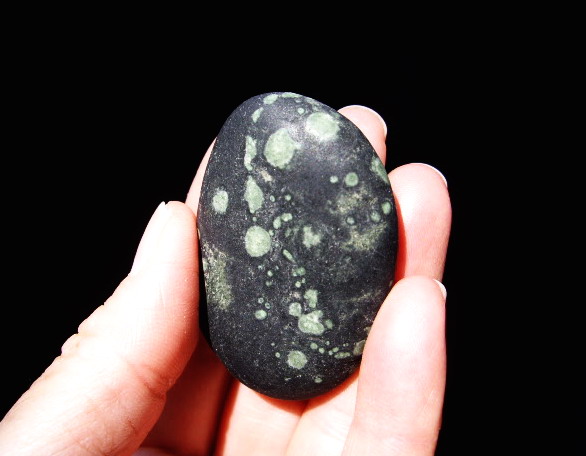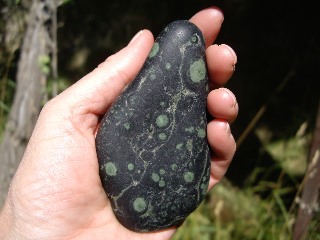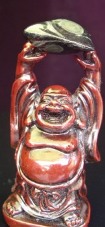"It is unlike anything
any of us have ever seen”
“I cannot find anything like it in the literature.”
“This rock is obviously something New or at least Unusual.”
American Museum of Natural History
Dept. of Earth and Planetary Sciences
______________________________________________________________________________________________
"Your
specimen is nephrite, a variety of jade. To determine
this I looked at a thin section. What makes it unusual is the fact
that it has orbicular structure. “Orbicular” implies that the rock
contains “concentric shells of different texture and/or mineralogy
about a central core.”
...and
afterwards by phone they said their conclusion of Nephrite was in
error and then said “We have never seen this type stone and cannot
figure out what it is and where it came from.”
Smithsonian Institution
National
Museum of Natural History
Rock and Ore Collection
_____________________________________________________________________________________________________________________
"Jadeite, a member of the pyroxene group
has the formula: (NA, AL, FE) SI2 06.
This is a much better fit to your X-ray energy dispersive analysis (EDX)
results.
In conclusion I think it is Jadeite, and perhaps the special version
Chloromelanite."
Douglass
minerals
Retired mineralogical researcher UCLA.
________________________________________________________________________________________________________________________
"It is a fresh and Unusual alkalik volcanic rock predominantly composed of the four minerals Quartz, Anorthoclase, Riebeckite and Aegirine. The light green spherules you see in the stone composed of radiating fibers are Riebeckite needles mantled with fine grained Aegirine. The darker matrix is richer in Riebeckite and also contains more Quartz.”
Consulting Petrographer. Globo De Plomo
Co-Author of Mineralogy of Arizona
_______________________________________________________________________________________________________________________
You may have seen a new lapidary material being offered for sale recently. It's called "Nebula StoneTM," and is a dark-green, nearly black, shiny material with fascinating, light-green, swirling orbicules scattered through the dark matrix. These inclusions make the rock look like the night sky viewed through a telescope, wherein you see galaxies, nebulae and individual stars scattered against a dark background- hence, the name Nebula Stone.
What makes Nebula Stone
so unusual is that it has been analyzed by several noted scientists without
anyone coming up with a definitive answer as to what type of rock it actually
is. Using a variety of recognized techniques, scientists have studied the rock
carefully, yet cannot come to a final, similar conclusion.
"It is highly regarded as an energy stone and healing stone by people
who are metaphysically attuned."
"The stone now enjoyed by the mineralogist, the lapidary and the spiritually inclined alike."
Bob Jones, Senior Editor
______________________________________________________________________________________

A note to Mineral Collectors
We have pages for those interested in the Scientific, the Geologic, the Mineralogical and the Esoteric for our many customers of varied interests.
Webster's dictionary: Esoteric/Metaphysical: Other than Physical. Relating to the transcendent or to a reality beyond what is perceptible to the senses.
I received a call from a gruff sounding gentleman that wanted to know about Nebula Stone. I didn't know what his interests were so I mentioned that he could read some of the stuff on the pages on our web site. I mentioned that there was scientific, Geologic/Mineralogical, Rock Hounding articles and esoteric/metaphysical writings.
He then said (real load) "Oh, I don't believe in that metaphysical Crap"
whereupon I asked
" Well then... tell me this.
"What... is... more... metaphysical... than the... belief... in God...?"
....silence on the other end of the phone.
Then he said... "hmm... I see."... then he laughed and said "Thank you for that."
We sell to all Mineral collectors no matter their belief systems. We are happy to help everyone in obtaining a fine mineral specimen for their collections. Nebula Stone is a recent geologic, mineralogical discovery, with a unique combination of minerals, named for it's Cosmological resemblance.
(the gentleman did acquire a fine Specimen for his collection.)
STARDUST TO STARDUST

Every atom in your body is billions of years old. Hydrogen, the most common element in the universe and a major feature of your body, was produced in the big bang 13.7bn years ago. Heavier atoms such as carbon and oxygen were forged in stars between 7bn and 12bn years ago, and blasted across space when the stars exploded. Some of these explosions were so powerful that they also produced the elements heavier than iron, which stars can't construct. This means that the components of your body are truly ancient: You are stardust.
Back to Mineralogical Analysis link page
Carl Sagan

Carl Sagan
Soon after entering elementary school, he began to express a
strong inquisitiveness about nature.
Sagan recalled taking his first trips to the public library alone, at the
age of five, when his mother got him a library card.
He wanted to learn what stars were, since none of his friends or their
parents could give him a clear answer:
"I went to the librarian and asked for a book about stars ...
And the answer was stunning.
It was that the Sun was a star but really close.
The stars were suns, but so far away they were just little points of light
...
The scale of the universe suddenly opened up to me. It was a kind of
religious experience.
There was a magnificence to it, a grandeur, a scale which has never left me.
Never ever left me."*
Carl Sagan Cosmos Carl Sagan We are made of Star Stuff, We are in the Universe and the Universe is within us. "Just like the Nebulas, Just like Ourselves...Everything is Reborn and Continues".

"Keep Looking up" Jack Horkheimer 1938-2010
Top Rate!
Thanks Jack for your inspiration to us all.
"We are made of Star Stuff"
"We are in the Universe and the Universe is also within us."
Thanks Jack and Carl for your inspiration to us all.
And for opening our minds.
Colored Stone January February 2010
Nebula Stone Rock and Gem Magazine story
Newly updated:
The Discovery of Nebula Stone
"The Enchantment of Nebula Stone"
Large
Nebula Stone Gemstone
Palmstones

*
NEW
Nebula Stone Nuggets Tumbled Stones

* NEW Large Exquisite Nebula Palm Stones High-grade
* NEW Starburst Nebula Palm & Pocket Stones
Nebula Stone Gemstone Mineral Spheres

The Nebula Skull Crystal Skull
Nebula Stone Gemstone
Crystal Skulls

Alien Skull
Stone Supernova Discovery
Alien Skull Stone Supernova Discovery
Nebula Stone in The Book of Stones
Nebula Stone by JaneAnn Dow- Mayan Past
Nebula Stone Review by New Age Retailer
Melody's note about our Discovery
Metaphysical...Published Articles about Nebula Stone
Colored Stone January February 2010
Nebula Stone Rock and Gem Magazine Story
Nebula Stone Gemstone Knife Handle in the making
* NEW Chocolate Galaxy
* NEW Collector Gallery
Indiana Jones and the Kingdom of the Crystal Skull
___________________________
Please go see the New TV Cosmos series on Fox TV.
"The Cosmos a Spacetime Odyssey" with Neil Degrasse Tyssen
_______________________________________
* We are not set up for online shopping cart buying... so please E-mail us for a purchase.
If you wish you may share our link with others, just copy and paste www.nebulastone.com into your email.
Privacy: We do not give, sell, trade nor share any of your info!! It’s your stuff.
Color and appearance may vary depending on your monitor and settings.
* from Wikipedia
Crystals and Stones are not a substitute for medical treatment.
Nebula Stone makes no claims, and is not intended to diagnose, treat, cure, or prevent any disease.
If you need help in any way please consult your doctor or other health care practitioner regarding health issues.
Trade marking is internationally recognized to protect and guard against fraudulent imitations.


!["Some of the Things That Molecules Do"[22] March 16, 2014 (2014-03-16) The story begins with Tyson sitting at a campfire, and telling how the wolf changed through artificial selection, and selective breeding into the dog breeds around today. He then enters the Ship of Imagination, and explains natural selection with the process that helped to create the polar bears. Along the way he talks about DNA, genes and mutation. Next he goes to a forest and describes the Tree of life, this leads him to discussing the evolution of the eye. He then discusses extinction, by going to a monument called the Halls of Extinction, dedicated to the broken branches of the tree of life. Explaining the five great Extinction events. He then tells how some life has survived, and then focuses on the tardigrade. From there he talks about what other kinds of life might have been created on other worlds. He then goes to Saturn's moon Titan. From there he speculates about life and how it first began. He then returns to Earth and tells about abiogenesis and how life changed and evolved. The show ends with an animated sequence from the original series of life's evolution from one cell to humans](Cosmos;%20A%20Spacetime%20Odessey.jpg)